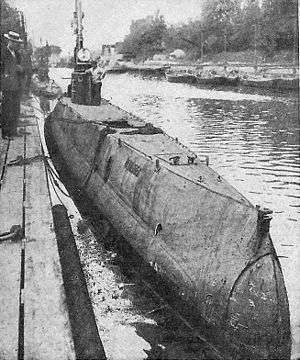SM U-23 (Austria-Hungary)
SM U-23 or U-XXIII was a U-20-class submarine or U-boat built for and operated by the Austro-Hungarian Navy (German: Kaiserliche und Königliche Kriegsmarine or K.u.K. Kriegsmarine) during the First World War. The design for U-23 was based on that of the submarines of the Royal Danish Navy's Havmanden class (which had been designed by Whitehead & Co. in Fiume), and was largely obsolete by the beginning of the war.
 The design for U-23 was based on that of the Havmanden class of the Royal Danish Navy (Havmanden pictured) | |
| History | |
|---|---|
| Name: | SM U-23 |
| Ordered: | 27 March 1915[1] |
| Builder: | Hungarian UBAG yard, Fiume[2] |
| Launched: | 5 January 1917[3] |
| Commissioned: | 1917[4] |
| Fate: | sunk by Italian destroyer Airone, 21 February 1918[3] |
| Service record | |
| Commanders: | Klemens Ritter von Bézard[5] |
| Victories: | None[5] |
| General characteristics | |
| Type: | U-20-class submarine |
| Displacement: |
|
| Length: | 127 ft 2 in (38.76 m)[3] |
| Beam: | 13 ft (4.0 m)[3] |
| Draft: | 9 ft (2.7 m)[3] |
| Propulsion: |
|
| Speed: |
|
| Range: |
|
| Complement: | 18[3] |
| Armament: |
|
U-23 was just over 127 feet (39 m) long and was armed with two bow torpedo tubes, a deck gun, and a machine gun. In February 1918, U-23 was sunk with all hands by the Italian torpedo boat Airone while attempting an attack on the Italian transport Memfi. U-23 had no wartime successes.
Design and construction
When it became apparent to the Austro-Hungarian Navy that the First World War would not be a short one,[1] they moved to bolster their U-boat fleet by seizing the plans for the Danish Havmanden class submarines,[2] which had been designed by Whitehead & Co. in Fiume, who had built three units.[6] Although the Austro-Hungarian Navy was not happy with the design, which was largely obsolete,[4][7] it was the only design for which plans were available and which could be begun immediately in domestic shipyards.[7] The Austro-Hungarian Navy unenthusiastically placed orders for U-23 and her three sister boats on 27 March 1915.[1]
U-23 was one of two boats of the class to be built at the Hungarian UBAG yard in Fiume.[2] Due to demands by the Hungarian government,[1] subcontracts for the class were divided between Hungarian and Austrian firms,[3] and this politically expedient solution worsened technical problems with the design, resulting in numerous modifications and delays for the class in general.[2]
U-23 was an ocean-going submarine that displaced 173 tonnes (191 short tons) surfaced and 210 tonnes (231 short tons) submerged and was designed for a complement of 18. She was 127 feet 2 inches (38.76 m) long with a beam of 13 feet (4.0 m) and a draft of 9 feet (2.7 m). For propulsion, she featured a single shaft, a single 450 bhp (340 kW) diesel engine for surface running, and a single 160 shp (120 kW) electric motor for submerged travel.[3] She was capable of 12 knots (22 km/h) while surfaced and 9 knots (17 km/h) while submerged. Although there is no specific notation of a range for U-23, the Havmanden class, upon which the U-20 class was based, had a range of 1,400 nautical miles (2,600 km) at 10 knots (19 km/h), surfaced, and 23 nautical miles (43 km) at 8 knots (15 km/h) submerged.[6]
U-23 was armed with two 45 cm (17.7 in) torpedo tubes located in the front and carried a complement of two torpedoes. She was also equipped with a 66 mm (2.6 in)/26 deck gun and an 8 mm (0.31 in) machine gun.[3]
Service career
U-23 was launched on 5 January 1917,[3] but It is not known with certainty when U-23 was commissioned. Author Paul Halpern reports that U-23 and her three sisters all entered service between August and November 1917.[4] Although there are no specific reports of problems with U-23, the U-20 class as a whole suffered from unreliable engines which compounded the poor handling characteristics of the boats.[4] On 21 February 1918,[8] Linienschiffsleutnant Klemens Ritter von Bézard, U-23's only commanding officer,[5] was guiding the boat in an attack on the Italian transport Memfi in the Straits of Otranto. U-23 came under attack by the Italian torpedo boat Airone which first tried to ram the U-boat, and then deployed an explosive paravane. When the paravane contacted the submerged U-23, it exploded, blowing debris into the air and sinking the submarine with all hands.[8] Like all of her sister boats,[2] U-23 had no wartime successes.[5]
References
- Halpern, p. 382.
- Gardiner, p. 344.
- Gardiner, p. 343.
- Halpern, p. 383.
- Helgason, Guðmundur. "WWI U-boats: KUK U23". German and Austrian U-boats of World War I - Kaiserliche Marine - Uboat.net. Retrieved 29 November 2008.
- Gardiner, p. 354.
- Gardiner, p. 341.
- Grant, p. 163.
Bibliography
- Gardiner, Robert, ed. (1985). Conway's All the World's Fighting Ships, 1906–1921. Annapolis, Maryland: Naval Institute Press. ISBN 978-0-87021-907-8. OCLC 12119866.CS1 maint: extra text: authors list (link)
- Gibson, R. H.; Prendergast, Maurice (2003) [1931]. The German Submarine War, 1914–1918. Annapolis, Maryland: Naval Institute Press. ISBN 978-1-59114-314-7. OCLC 52924732.
- Grant, Robert M. (2002) [1964]. U-boats Destroyed: The Effect of Anti-submarine Warfare, 1914–1918. Penzance: Periscope. ISBN 978-1-904381-00-6. OCLC 50215640.
- Halpern, Paul G. (1994). A Naval History of World War I. Annapolis, Maryland: Naval Institute Press. ISBN 978-0-87021-266-6. OCLC 28411665.